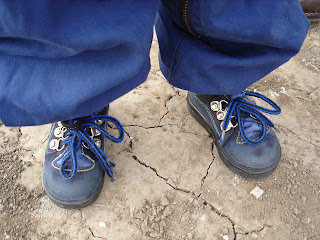
Being the “Rebar Queen”, I thought I might fill you in on a few more details …
Upon our arrival we were shown the four duplexes (eight homes) that were started last year. They are almost finished and during our stay four kitchens were installed - looking great - and I spent the last two days cutting and applying external insulation to the base of the last duplex. The families are keen to move in!

The first six days were spent preparing two new slabs. For this new stage, three duplexes and a playground are being constructed. We completed two slabs. I did mention a little about rebar last time, but you’ll have to indulge me here as I present a step-by-step guide to tying rebar: (we did tie over 10,000 of these - I think we were tying re-bar in our dreams!)

Firstly the reinforced steel bars need to be placed accurately every 25 cms. both width-ways and length-ways. At first we used a tape measure but then innovatively used wooden spacers cut to the correct length. Linda, from Banff in Canada, and I worked as a pair for a couple of days and after completing 3 metres were only 0.5 cm. out - pretty good!


Next, one would hold the bars in position while the other did the wire wrap and twist.

The centre of the wire would be placed across the upper, width-ways bar, then under the length-ways bar - each side, finally being brought up over the top again and twisted securely in place using pliers.

A number of variations were introduced … clockwise twist, anti-clockwise twist, pre-bent wires (Linda’s favourite was the fish-shape), twisted wires up, twisted wires down, two short wires on diagonals, no wedge, a single wedge to lift the bar below or what became know as the ‘Lloyd Bridge’ where a wedge was placed under all the length-ways bars at once (invented by Lloyd from Chicago).

Knee pads were used by some, others squatted, some sat others used upturned buckets. Although tiring, there were lots of laughs and it was fun working with others. I developed ‘rebar wrist’, and towards the end ‘rebar knee’ was also becoming a problem for a few of ‘team rebar’.

Once the bottom layer was completed on the lower pouring of concrete, rebar boxes were made and secured on all four sides then an upper layers of rebar was placed above the lower. This was much easier to do and we didn’t need to be a pair - just a group to complete the layer.
While we ‘rebarred’, John and others were involved with building a wooden frame to support the concrete as it was being poured. I must admit initially I thought we would be mixing it as well but it arrived in trucks and although I helped a little with the pour on the first slab and placed the upright rods (I’m not sure what they are called) into the drying cement, I really had little to do with the concrete and kept on tying rebar.

Pouring, moving and smoothing out the concrete was pretty hard work but the slabs were excellent. On the final day John spent most of the time removing the wooden frames and chipping away set concrete from the sides - exhausting work. As a grand finale we planned to hold a dance on the first slab, with some Hungarian instructors to teach us, but for some reason the instructors couldn’t make it.
As the families have a job to earn income, during the day only Judit, a mother of four whose husband works away from home, and Pisti who is a baker and works during the early hours of the morning were on the site with us each day - they complete their hours on whatever home needs work. Other home owners came when they could, but mostly they worked of an evening and on the weekend when we weren’t there.

As the second slab was being finished, I waited for John and thought it was lovely to see the two future homeowners of the duplex (Pisti and Sandor) - future neighbours - working side by side with John and Kai from central Saskatchewan.

On the last afternoon, it was with a tinge of sadness I hung up my apron and left my tools - particularly my trusty pliers, but what a wonderful experience that we‘ve had the privilege to be part of.

On the last night, Erzsebet, one of the wives and mothers, cooked a traditional Hungarian goulash in a huge cauldron over an open fire and a number of families joined us as we consumed the delicious brew. It was wonderful to have the children there and get to know them a little - aren’t these tiny feet so cute!

Through translation by those who could speak both languages, we were so pleased to know that we as volunteers, and Habitat for Humanity as an organization, makes such a big differences in the lives of these families and the futures of their precious children.


It was a great evening to finish off our time in Hajduboszormeny.


No comments:
Post a Comment